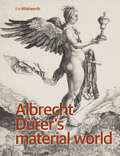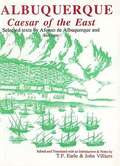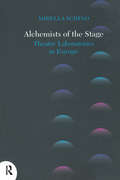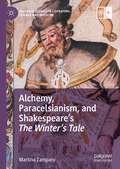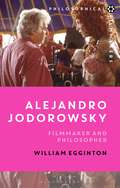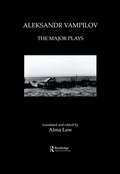- Table View
- List View
Albrecht Durer: A Guide to Research (Artist Resource Manuals)
by Jane Campbell HutchisonHutchison's book is a complete guide on Durer and the research on his work, his historical import and his aesthetic legacy.
Albrecht Dürer and the Depiction of Cultural Differences in Renaissance Europe (Routledge Critical Junctures in Global Early Modernities)
by Heather MadarThis book provides a comprehensive assessment of Dürer’s depictions of human diversity, focusing particularly on his depictions of figures from outside his Western European milieu. Heather Madar contextualizes those depictions within their broader artistic and historical context and assesses them in light of current theories about early modern concepts of cultural, ethnic, religious and racial diversity. The book also explores Dürer’s connections with contemporaries, his later legacy with respect to his imagery of the other and the broader significance of Nuremberg to early modern engagements with the world beyond Europe. The book will be of interest to scholars working in art history, Renaissance studies and Renaissance history.
Albrecht Dürer and the Depiction of Cultural Differences in Renaissance Europe (Routledge Critical Junctures in Global Early Modernities)
by Heather MadarThis book provides a comprehensive assessment of Dürer’s depictions of human diversity, focusing particularly on his depictions of figures from outside his Western European milieu. Heather Madar contextualizes those depictions within their broader artistic and historical context and assesses them in light of current theories about early modern concepts of cultural, ethnic, religious and racial diversity. The book also explores Dürer’s connections with contemporaries, his later legacy with respect to his imagery of the other and the broader significance of Nuremberg to early modern engagements with the world beyond Europe. The book will be of interest to scholars working in art history, Renaissance studies and Renaissance history.
Albrecht Dürer and the Epistolary Mode of Address
by Shira BrismanArt historians have long looked to letters to secure biographical details; clarify relationships between artists and patrons; and present artists as modern, self-aware individuals. This book takes a novel approach: focusing on Albrecht Dürer, Shira Brisman is the first to argue that the experience of writing, sending, and receiving letters shaped how he treated the work of art as an agent for communication. In the early modern period, before the establishment of a reliable postal system, letters faced risks of interception and delay. During the Reformation, the printing press threatened to expose intimate exchanges and blur the line between public and private life. Exploring the complex travel patterns of sixteenth-century missives, Brisman explains how these issues of sending and receiving informed Dürer’s artistic practices. His success, she contends, was due in large part to his development of pictorial strategies—an epistolary mode of address—marked by a direct, intimate appeal to the viewer, an appeal that also acknowledged the distance and delay that defers the message before it can reach its recipient. As images, often in the form of prints, coursed through an open market, and artists lost direct control over the sale and reception of their work, Germany’s chief printmaker navigated the new terrain by creating in his images a balance between legibility and concealment, intimacy and public address.
Albrecht Dürer and the Epistolary Mode of Address
by Shira BrismanArt historians have long looked to letters to secure biographical details; clarify relationships between artists and patrons; and present artists as modern, self-aware individuals. This book takes a novel approach: focusing on Albrecht Dürer, Shira Brisman is the first to argue that the experience of writing, sending, and receiving letters shaped how he treated the work of art as an agent for communication. In the early modern period, before the establishment of a reliable postal system, letters faced risks of interception and delay. During the Reformation, the printing press threatened to expose intimate exchanges and blur the line between public and private life. Exploring the complex travel patterns of sixteenth-century missives, Brisman explains how these issues of sending and receiving informed Dürer’s artistic practices. His success, she contends, was due in large part to his development of pictorial strategies—an epistolary mode of address—marked by a direct, intimate appeal to the viewer, an appeal that also acknowledged the distance and delay that defers the message before it can reach its recipient. As images, often in the form of prints, coursed through an open market, and artists lost direct control over the sale and reception of their work, Germany’s chief printmaker navigated the new terrain by creating in his images a balance between legibility and concealment, intimacy and public address.
Albrecht Dürer and the Epistolary Mode of Address
by Shira BrismanArt historians have long looked to letters to secure biographical details; clarify relationships between artists and patrons; and present artists as modern, self-aware individuals. This book takes a novel approach: focusing on Albrecht Dürer, Shira Brisman is the first to argue that the experience of writing, sending, and receiving letters shaped how he treated the work of art as an agent for communication. In the early modern period, before the establishment of a reliable postal system, letters faced risks of interception and delay. During the Reformation, the printing press threatened to expose intimate exchanges and blur the line between public and private life. Exploring the complex travel patterns of sixteenth-century missives, Brisman explains how these issues of sending and receiving informed Dürer’s artistic practices. His success, she contends, was due in large part to his development of pictorial strategies—an epistolary mode of address—marked by a direct, intimate appeal to the viewer, an appeal that also acknowledged the distance and delay that defers the message before it can reach its recipient. As images, often in the form of prints, coursed through an open market, and artists lost direct control over the sale and reception of their work, Germany’s chief printmaker navigated the new terrain by creating in his images a balance between legibility and concealment, intimacy and public address.
Albrecht Dürer and the Epistolary Mode of Address
by Shira BrismanArt historians have long looked to letters to secure biographical details; clarify relationships between artists and patrons; and present artists as modern, self-aware individuals. This book takes a novel approach: focusing on Albrecht Dürer, Shira Brisman is the first to argue that the experience of writing, sending, and receiving letters shaped how he treated the work of art as an agent for communication. In the early modern period, before the establishment of a reliable postal system, letters faced risks of interception and delay. During the Reformation, the printing press threatened to expose intimate exchanges and blur the line between public and private life. Exploring the complex travel patterns of sixteenth-century missives, Brisman explains how these issues of sending and receiving informed Dürer’s artistic practices. His success, she contends, was due in large part to his development of pictorial strategies—an epistolary mode of address—marked by a direct, intimate appeal to the viewer, an appeal that also acknowledged the distance and delay that defers the message before it can reach its recipient. As images, often in the form of prints, coursed through an open market, and artists lost direct control over the sale and reception of their work, Germany’s chief printmaker navigated the new terrain by creating in his images a balance between legibility and concealment, intimacy and public address.
Albrecht Dürer’s material world
by Edward H. Wouk and Jennifer SpinksThe painter and printmaker Albrecht Dürer is one of the most important figures of the German Renaissance. This book accompanies the first major exhibition of the Whitworth art gallery’s outstanding Dürer collection in over half a century. It offers a new perspective on Dürer as an intense observer of the worlds of manufacture, design and trade that fill his graphic art.Artworks and artefacts examined here expose understudied aspects of Dürer’s art and practice, including his attentive examination of objects of daily domestic use, his involvement in economies of local manufacture and exchange, the microarchitectures of local craft and, finally, his attention to cultures of natural and philosophical inquiry and learning.
Albrecht Dürer’s material world
by Edward H. Wouk Jennifer SpinksThe painter and printmaker Albrecht Dürer is one of the most important figures of the German Renaissance. This book accompanies the first major exhibition of the Whitworth art gallery’s outstanding Dürer collection in over half a century. It offers a new perspective on Dürer as an intense observer of the worlds of manufacture, design and trade that fill his graphic art.Artworks and artefacts examined here expose understudied aspects of Dürer’s art and practice, including his attentive examination of objects of daily domestic use, his involvement in economies of local manufacture and exchange, the microarchitectures of local craft and, finally, his attention to cultures of natural and philosophical inquiry and learning.
The Album of the World Emperor: Cross-Cultural Collecting and the Art of Album-Making in Seventeenth-Century Istanbul
by Emine FetvacıThe first study of album-making in the Ottoman empire during the seventeenth century, demonstrating the period’s experimentation, eclecticism, and global outlookThe Album of the World Emperor examines an extraordinary piece of art: an album of paintings, drawings, calligraphy, and European prints compiled for the Ottoman sultan Ahmed I (r. 1603–17) by his courtier Kalender Paşa (d. 1616). In this detailed study of one of the most important works of seventeenth-century Ottoman art, Emine Fetvacı uses the album to explore questions of style, iconography, foreign inspiration, and the very meaning of the visual arts in the Islamic world.The album’s thirty-two folios feature artworks that range from intricate paper cutouts to the earliest examples of Islamic genre painting, and contents as eclectic as Persian and Persian-influenced calligraphy, studies of men and women of different ethnicities and backgrounds, depictions of popular entertainment and urban life, and European prints depicting Christ on the cross that in turn served as models for apocalyptic Ottoman paintings. Through the album, Fetvacı sheds light on imperial ideals as well as relationships between court life and popular culture, and shows that the boundaries between Ottoman art and the art of Iran and Western Europe were much more porous than has been assumed. Rather than perpetuating the established Ottoman idiom of the sixteenth century, the album shows that this was a time of openness to new models, outside sources, and fresh forms of expression.Beautifully illustrated and featuring all the folios of the original seventy-page album, The Album of the World Emperor revives a neglected yet significant artwork to demonstrate the distinctive aesthetic innovations of the Ottoman court.
The Album of the World Emperor: Cross-Cultural Collecting and the Art of Album-Making in Seventeenth-Century Istanbul
by Emine FetvacıThe first study of album-making in the Ottoman empire during the seventeenth century, demonstrating the period’s experimentation, eclecticism, and global outlookThe Album of the World Emperor examines an extraordinary piece of art: an album of paintings, drawings, calligraphy, and European prints compiled for the Ottoman sultan Ahmed I (r. 1603–17) by his courtier Kalender Paşa (d. 1616). In this detailed study of one of the most important works of seventeenth-century Ottoman art, Emine Fetvacı uses the album to explore questions of style, iconography, foreign inspiration, and the very meaning of the visual arts in the Islamic world.The album’s thirty-two folios feature artworks that range from intricate paper cutouts to the earliest examples of Islamic genre painting, and contents as eclectic as Persian and Persian-influenced calligraphy, studies of men and women of different ethnicities and backgrounds, depictions of popular entertainment and urban life, and European prints depicting Christ on the cross that in turn served as models for apocalyptic Ottoman paintings. Through the album, Fetvacı sheds light on imperial ideals as well as relationships between court life and popular culture, and shows that the boundaries between Ottoman art and the art of Iran and Western Europe were much more porous than has been assumed. Rather than perpetuating the established Ottoman idiom of the sixteenth century, the album shows that this was a time of openness to new models, outside sources, and fresh forms of expression.Beautifully illustrated and featuring all the folios of the original seventy-page album, The Album of the World Emperor revives a neglected yet significant artwork to demonstrate the distinctive aesthetic innovations of the Ottoman court.
Albuquerque: Caesar of the East. Selected Texts by Afonso de Albuquerque and His Son (Aris & Phillips Hispanic Classics)
by Tom Earle John VilliersOf all the remarkable people who first opened up the rest of the world to the Europeans Columbus, Magellan, Vasco da Gama, Pizarro and Cortes Afonso de Albuquerque, governor of Portuguese India from 1509 to 1515, was one of the most astonishing. He was a commander of bold strategic conceptions, a far-sighted administrator and in addition a talented writer, whose dispatches to King Manuel contain a wealth of spontaneous narrative, description and pungent comment. Caesar of the East is a specially edited anthology, based on the original Portuguese texts, of selections from these dispatches, or Cartas , and from the Comentarios (Commentaries) written by Albuquerque's son, also called Afonso, about his father's career, with new English translations of both. In the introduction Dr Villiers evaluates the part that Albuquerque played in the foundation of the Portuguese empire in Asia, and Dr Earle provides a literary analysis of the contrasting styles of the Cartas and the Comentarios , where the father's informality and spontaneity contrast fascinatingly with his son's carefully contrived and highly literary narrative. Historical and geographical notes help the reader to understand the text.
Alchemists of the Stage: Theatre Laboratories in Europe (Routledge Icarus Ser.)
by Mirella SchinoWhat is a theatre laboratory? Why a theatre laboratory? This book tries to answer these questions focusing on the experiences and theories, the visions and the techniques, the differences and similarities of European theatre laboratories in the twentieth century. It studies in depth the Studios of Stanislavski and Meyerhold, the school of Decroux, the Teatr Laboratorium of Jerzy Grotowski and Ludwik Flaszen, as well as Eugenio Barba's Odin Teatret. Theatre laboratories embody a theatre practice which defies the demands and fashions of the times, the usual ways of production and the sensible functions which stage art enjoys in our society. It is a theatre which refuses to be only art and whose radical research forges new conditions with a view to changing both the actor and the spectator. This research transforms theatrical craft into a laboratory which has been compared to the laboratory of the alchemists, who worked not on material but on substance. The alchemists of the stage did not operate only on forms and styles, but mainly on the living matter of the theatre: the actor, seen not just as an artist but above all as a representative of a new human being. Laboratory theatres have rarely been at the centre of the news. Yet their underground activity has influenced theatre history. Without them, the same idea of theatre, as it has been shaped in the course of the twentieth century, would have been different. In this book Mirella Schino recounts, as in a novel, the vicissitudes of a group of practitioners and scholars who try to uncover the technical, political and spiritual perspectives behind the word laboratory when applied to the theatre.
Alchemists of the Stage: Theatre Laboratories in Europe (Routledge Icarus Ser.)
by Mirella SchinoWhat is a theatre laboratory? Why a theatre laboratory? This book tries to answer these questions focusing on the experiences and theories, the visions and the techniques, the differences and similarities of European theatre laboratories in the twentieth century. It studies in depth the Studios of Stanislavski and Meyerhold, the school of Decroux, the Teatr Laboratorium of Jerzy Grotowski and Ludwik Flaszen, as well as Eugenio Barba's Odin Teatret. Theatre laboratories embody a theatre practice which defies the demands and fashions of the times, the usual ways of production and the sensible functions which stage art enjoys in our society. It is a theatre which refuses to be only art and whose radical research forges new conditions with a view to changing both the actor and the spectator. This research transforms theatrical craft into a laboratory which has been compared to the laboratory of the alchemists, who worked not on material but on substance. The alchemists of the stage did not operate only on forms and styles, but mainly on the living matter of the theatre: the actor, seen not just as an artist but above all as a representative of a new human being. Laboratory theatres have rarely been at the centre of the news. Yet their underground activity has influenced theatre history. Without them, the same idea of theatre, as it has been shaped in the course of the twentieth century, would have been different. In this book Mirella Schino recounts, as in a novel, the vicissitudes of a group of practitioners and scholars who try to uncover the technical, political and spiritual perspectives behind the word laboratory when applied to the theatre.
Alchemy, Jung, and Remedios Varo: Cultural Complexes and the Redemptive Power of the Abjected Feminine (Research in Analytical Psychology and Jungian Studies)
by Dennis PottengerAlchemy, Jung, and Remedios Varo offers a depth psychological analysis of the art and life of Remedios Varo, a Spanish surrealist painter. The book uses Varo’s paintings in a revolutionary way: to critique the patriarchal underpinnings of Jungian psychology, alchemy, and Surrealism, illuminating how Varo used painting to address cultural complexes that silence female expression. The book focuses on how the practice of alchemical psychology, through the power of imagination and the archetypal Feminine, can lead to healing and transformation for individuals and culture. Alchemy, Jung, and Remedios Varo offers the first in-depth psychological treatment of the role alchemy played in the friendship between Varo and Leonora Carrington—a connection that led to paintings that protest the pitfalls of patriarchy. This unique book will be of great interest for academics, scholars, and post-graduate students in the fields of analytical psychology, art history, Surrealism, cultural criticism, and Jungian studies.
Alchemy, Jung, and Remedios Varo: Cultural Complexes and the Redemptive Power of the Abjected Feminine (Research in Analytical Psychology and Jungian Studies)
by Dennis PottengerAlchemy, Jung, and Remedios Varo offers a depth psychological analysis of the art and life of Remedios Varo, a Spanish surrealist painter. The book uses Varo’s paintings in a revolutionary way: to critique the patriarchal underpinnings of Jungian psychology, alchemy, and Surrealism, illuminating how Varo used painting to address cultural complexes that silence female expression. The book focuses on how the practice of alchemical psychology, through the power of imagination and the archetypal Feminine, can lead to healing and transformation for individuals and culture. Alchemy, Jung, and Remedios Varo offers the first in-depth psychological treatment of the role alchemy played in the friendship between Varo and Leonora Carrington—a connection that led to paintings that protest the pitfalls of patriarchy. This unique book will be of great interest for academics, scholars, and post-graduate students in the fields of analytical psychology, art history, Surrealism, cultural criticism, and Jungian studies.
The Alchemy of Paint: Art, Science And Secrets From The Middle Ages
by Spike BucklowSpike Bucklow sets out to unravel the myths behind the pigments, like dragonsblood, which is said to be a mixture of elephant and dragon blood. Examining both the medieval palette and the often cloak-and-dagger science that created it, he uncovers the secret recipes behind the luxurious colours we are familiar with today. Driven by an overriding passion for art, Spike Bucklow's aim is to restore value to colour.
Alchemy, Paracelsianism, and Shakespeare’s The Winter’s Tale (Palgrave Studies in Literature, Science and Medicine)
by Martina ZamparoThis book explores the role of alchemy, Paracelsianism, and Hermetic philosophy in one of Shakespeare’s last plays, The Winter’s Tale. A perusal of the vast literary and iconographic repertory of Renaissance alchemy reveals that this late play is imbued with several topoi, myths, and emblematic symbols coming from coeval alchemical, Paracelsian, and Hermetic sources. It also discusses the alchemical significance of water and time in the play’s circular and regenerative pattern and the healing role of women. All the major symbols of alchemy are present in Shakespeare’s play: the intertwined serpents of the caduceus, the chemical wedding, the filius philosophorum, and the so-called rex chymicus. This book also provides an in-depth survey of late Renaissance alchemy, Paracelsian medicine, and Hermetic culture in the Elizabethan and Jacobean ages. Importantly, it contends that The Winter’s Tale, in symbolically retracing the healing pattern of the rota alchemica and in emphasising the Hermetic principles of unity and concord, glorifies King James’s conciliatory attitude.
Alcohol Ink: Step-by-Step Techniques for Ink-Based Fluid Art
by Desirée DelâgeMake incredible art with ink! • Discover the vibrant world of alcohol ink, the creative craze that's the hottest new art trend since paint pouring. • Learn everything you need to know about working with this expressive medium and how to create striking ink art. • Follow over 20 step-by-step tutorials and benefit from expert tips plus a wealth of colourful DIY inspiration. Alcohol inks have exploded onto the art scene with the rise of fluid art techniques such as paint pouring. These accessible inks can be used to create stunning abstract art, even if you're a total beginner. Through step-by-step tutorials and exercises, you'll learn everything you need to know to get started with alcohol ink and how to combine techniques into incredible, bold and colourful, abstract art. As well as paintings on paper, you'll discover inspiration and advice on using the techniques to decorate a wide range of surfaces, including ceramics, plastic, glass, wood and more to make fashion and home accessories and striking handmade gifts.
Aleister Crowley: The Beast Demystified
by Roger HutchinsonAleister Crowley (1875-1947) - mystic, writer, poet, astrologer, sexual revolutionary, painter, mountain climber and social critic - has a terrifying reputation. The contemporary press labelled him the 'wickedest man in the world', while he called himself the 'great beast'. Crowley dabbled in the occult, supported Germany in the First World War, was addicted to opiates, and many who associated with him died tragically in mysterious circumstances.Working from the starting point that behind the demonic reputation there stood a human being, and that beyond the self-proclaimed black magician there was a man hungry for publicity and fame, Roger Hutchinson lifts the smokescreen of mythology to reveal a truly astonishing figure.Why did this curious product of the Plymouth Brethren found the first 'hippy commune' in Sicily? What led this Cambridge graduate to be celebrated 20 years after his death on the cover of The Beatles' Sergeant Pepper's Lonely Hearts Club Band album? Why did Mussolini expel him from Italy? Why did a British magazine label him 'the man we'd like to hang'? Roger Hutchinson reveals the real Crowley: warts, wickedness, talent, courage, cowardice and all.
Alejandro Amenábar (Spanish and Latin-American Filmmakers)
by Barry JordanSince the release of his first feature in 1996, Alejandro Amenábar has become the ‘golden boy’ of Spanish filmmaking, a bankable star director whose brand virtually guarantees quality, big audiences and domestic box office success. He has directed three of the highest-grossing movies in Spanish film history and has enjoyed enormous international and critical acclaim, including an Oscar for Best Foreign Film for Mar Adentro/The Sea Inside, 2004. This book is the first full-length study in English of Amenábar’s shorts and feature films. It provides detailed analysis of his engagement with popular film genres as the basis for an auteur cinema and incorporates a reappraisal of his auteurism as fundamentally decentred and shared. An essential resource for students, scholars and fans of Amenábar, the book will also appeal to a wider readership, including professionals in the film, media and culture industries as well as those who have a general interest in the best of Spanish, European and world cinema.
Alejandro Jodorowsky: Filmmaker and Philosopher (Philosophical Filmmakers)
by William EggintonAlejandro Jodorowsky is a force of nature. At 90 years old he is still making films and is a cultural phenomenon who has influenced other artists as disparate as John Waters and Yoko Ono. Although his body of work has long been considered disjointed and random, William Egginton claims that Jodorowsky's writings, theatre work and mime, and his films, along with the therapeutic practice he calls psychomagic, can all be tied together to form the philosophical programme that underpins his films. Incorporating surrealism and thinkers including Lacan, Kant, Hegel, and Žižek into his interpretation of Jodorowsky's work, Egginton shows how his diverse films are connected by interpretive practices with a fundamental similarity to Lacanian psychoanalysis. Using case studies of Jodorowsky's cult films, El Topo, Fando y Lis and Holy Mountain and more, this book provides a unique perspective on a filmmaker whose work has been notoriously difficult to analyse.
Alejandro Jodorowsky: Filmmaker and Philosopher (Philosophical Filmmakers)
by William EggintonAlejandro Jodorowsky is a force of nature. At 90 years old he is still making films and is a cultural phenomenon who has influenced other artists as disparate as John Waters and Yoko Ono. Although his body of work has long been considered disjointed and random, William Egginton claims that Jodorowsky's writings, theatre work and mime, and his films, along with the therapeutic practice he calls psychomagic, can all be tied together to form the philosophical programme that underpins his films. Incorporating surrealism and thinkers including Lacan, Kant, Hegel, and Žižek into his interpretation of Jodorowsky's work, Egginton shows how his diverse films are connected by interpretive practices with a fundamental similarity to Lacanian psychoanalysis. Using case studies of Jodorowsky's cult films, El Topo, Fando y Lis and Holy Mountain and more, this book provides a unique perspective on a filmmaker whose work has been notoriously difficult to analyse.
Aleksandr Vampilov: The Major Plays
by Alma LawFirst Published in 1996. Routledge is an imprint of Taylor & Francis, an informa company.
Aleksandr Vampilov: The Major Plays (Russian Theatre Archive Ser. #Vol. 6.)
by Alma LawFirst Published in 1996. Routledge is an imprint of Taylor & Francis, an informa company.



